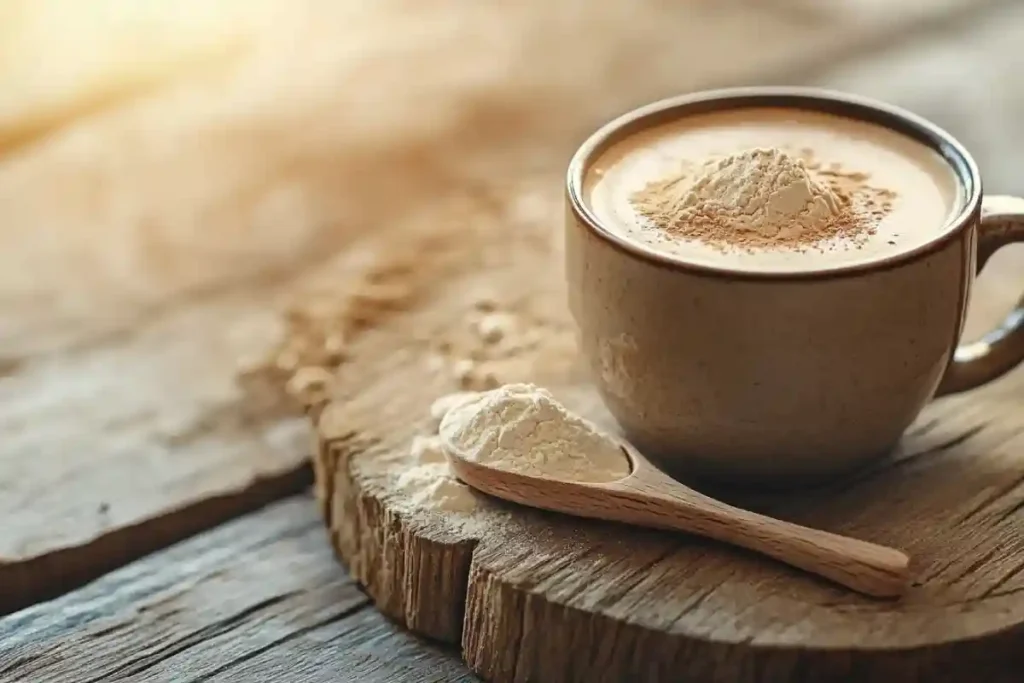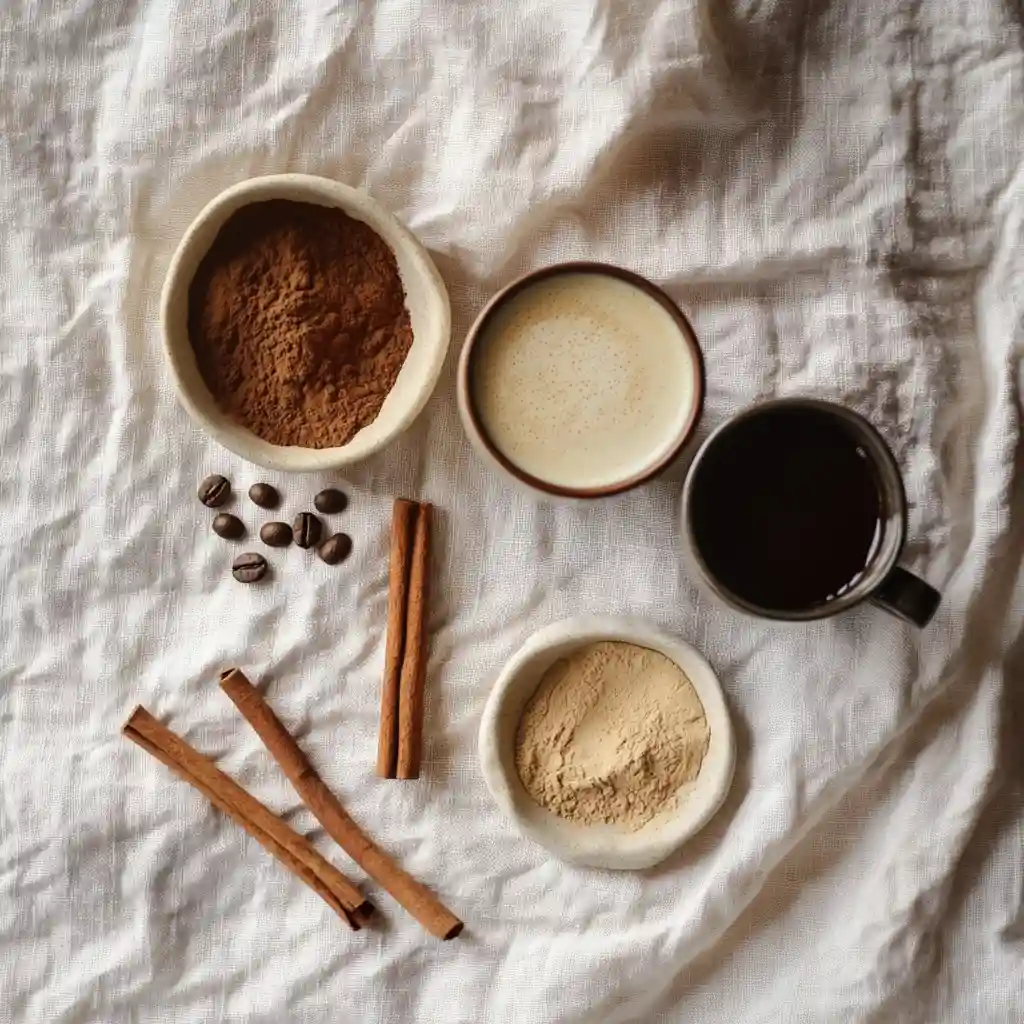
Table of Contents
We’ll kick things off by diving into the comforting backstory of how my go-to protein coffee recipe became a daily staple here in Austin, especially after those long shifts in the kitchen. It’s not just coffee anymore—it’s fuel with function. Then, we’ll walk through different types of proteins you can blend into your brew, plus exactly how much to use for flavor and balance. Each part includes internal links to helpful recipes and tips from Flavivo Trends, and one solid external link to explain the real science behind caffeine and protein working together.
Why a Protein Coffee Recipe Became Part of My Daily Routine
My early mornings demanded more than caffeine
Back when I was working the brunch line at a restaurant in New Orleans, mornings were chaos. Coffee was essential, but I’d crash hard around 10 a.m. That’s when I started tossing in a scoop of vanilla whey protein. It gave my brew body, a mild sweetness, and just enough staying power to keep me from reaching for a donut mid-shift. That habit followed me to Austin, and now, whether I’m writing up a new post for Flavivo Trends or testing recipes like my Zero Carb Yogurt Bread, that protein coffee is always nearby.
The magic of combining fuel and flavor
The thing is, protein coffee isn’t just practical—it tastes amazing when done right. It becomes this creamy, frothy latte-like drink without needing syrup or cream. Plus, I noticed I stayed fuller longer and felt way more focused through the late-morning hours. I even turned a few of my test kitchen friends onto it when we were experimenting with dishes like this Beef Stuffed Shells with Creamy Ricotta. It’s one of those small tweaks that makes a big difference in your day.
Simple Ingredients and How to Make the Best Protein Coffee
Subheading: Your protein coffee starter kit

You don’t need a fancy espresso machine or a pantry full of powders to make this work. My base recipe is built around ingredients most folks already have, plus a scoop of your favorite protein. Here’s what I use on weekday mornings:
- 1 cup hot brewed coffee (strong is better)
- 1 scoop of vanilla or chocolate protein powder (whey, collagen, or plant-based all work)
- 1/4 cup milk or dairy-free alternative (almond, oat, or cashew are great)
- Optional: 1/2 tsp cinnamon or cocoa powder for flair
- Optional: sweetener of choice (monk fruit, stevia, or maple)
For something a little creamier, I sometimes stir in a dash of coconut milk, especially when I’m prepping recipes like this Creamy Mushroom and Asparagus Chicken Penne and need fuel that won’t weigh me down.
Step-by-step—blender or stir, you choose
The easiest method is blending, and here’s why: it gives you a frothy, café-style result without clumps. But you can still make it smooth with a shaker bottle or a handheld frother.

- Brew your coffee and pour it into a blender.
- Add protein powder and milk.
- Blend on low for 10–15 seconds until smooth and lightly foamy.
- Pour into your favorite mug and sip warm—or chill it with ice for a cold version.
That’s it. If you’re short on time, combine all the ingredients in a mason jar, shake it like a bartender, and you’ve got a quick grab-and-go coffee protein fix. I often enjoy this alongside leftover Fiery Chicken Ramen from the night before for a bold start.
The Real Health Benefits Behind Protein Coffee
What happens when you combine caffeine and protein
Pairing protein with your morning brew isn’t just about chasing trends. It’s all about starting your day on a more balanced note. When you drink a protein coffee recipe first thing in the morning, you’re giving your body quick energy from caffeine and lasting fuel from protein. That’s one reason it became a go-to for me during long testing days, especially while working on hearty meals like this Ground Beef Sweet Potato Bowl.
Coffee alone boosts alertness but often leaves you hungry too soon. Protein alone can be bland and boring. Mix them together, though, and you’ve got a bold, creamy combo that satisfies both your appetite and your brain.
How protein coffee compares to other morning options
Here’s a breakdown of how a protein coffee recipe stacks up next to traditional drinks. Whether you’re replacing a sugary latte or skipping breakfast entirely, this table lays it out clearly.
| Feature | Protein Coffee | Regular Coffee | Sugary Latte |
|---|---|---|---|
| Protein (g) | 20–25 | 0 | 5–8 (from milk) |
| Energy Duration | Sustained | Short spike | Short spike |
| Sugar (g) | 0–3 | 0 | 25–40 |
| Satiety | High | Low | Moderate |
This comparison shows why the protein coffee recipe has earned its spot in many fitness and kitchen routines.
You’ll notice the difference in how long it keeps you full. That’s exactly what I want when I’m meal-prepping high-protein dishes like Creamy Garlic Rotini with Chicken—you stay energized without needing snacks between tasks.
Key benefits and practical drawbacks to know
To make the best call for your lifestyle, here’s a quick-hit list of benefits and limitations:
Benefits of a protein coffee recipe:
- Combines quick energy and muscle support
- Keeps you full longer than standard coffee
- Helps reduce late-morning sugar cravings
- Great for busy mornings or light breakfast replacement
- Adapts easily for keto, low-carb, or plant-based diets
Limitations to consider:
- Texture can get gritty if not blended well
- Some flavored powders include artificial ingredients
- Doesn’t replace whole-food breakfasts long term
- It may impact digestion if eaten too quickly on an empty stomach.
How to Balance Flavor and Get the Texture Just Right
Avoid chalky textures with these simple tricks
The number one complaint I hear about protein coffee? “It’s gritty.” But that’s almost always a result of how you mix it, not the ingredients themselves. You don’t need a fancy machine—just a little technique. Here’s how I do it:
- Always add the protein powder after the coffee has cooled slightly (hot liquid can denature some proteins).
- Use a hand frother or immersion blender to fully combine.
- Shake with ice for an iced version—protein dissolves better cold if you’re using whey isolate.
- Don’t over-blend—30 seconds max, or it’ll foam too much.
When I’m prepping recipes like my Blueberry Fluffy Cottage Cheese Cloud Bread, I often make a cold version to sip alongside. It’s smooth, light, and pairs well with both savory and sweet dishes.
Flavor combos that actually work
You don’t need syrups or sugar bombs to enjoy protein coffee. Let the protein powder add its own base flavor, and complement it with pantry staples. Here are my favorite flavor blends that have stood the test of time in my kitchen:
Go-To Flavor Pairings:
- Vanilla whey + cinnamon + oat milk = smooth, cozy, no sugar needed
- Chocolate plant protein + chilled brew + almond milk = like a mocha shake
- Unflavored collagen + espresso + coconut cream = rich, keto-friendly combo
- Salted caramel protein + iced coffee + cashew milk = perfect summer energy fix
These work well even alongside full meals like Dolly’s Chicken and Stuffing Casserole—a protein-packed dinner that pairs beautifully with a cold, sweet coffee on the side.
If you’re experimenting, start small. Mix ½ scoop protein first, taste, then adjust. Add too much too quickly, and you risk overpowering the coffee. It’s all about balance.
FAQ About Protein Coffee Recipe
Can you mix protein with coffee?
Yes, absolutely. Mixing protein with coffee is safe and effective as long as the protein is designed to mix with liquids. Whey isolate, collagen, and some plant-based blends dissolve best. Avoid thick casein powders, which may clump.
What is the best protein to mix in coffee?
Unflavored or vanilla whey isolate is the most versatile for hot coffee. Collagen peptides work beautifully too and are heat-stable. For vegan options, go with pea or rice protein, and blend thoroughly to avoid chalkiness.
Is protein coffee actually healthy?
Yes, when made with clean protein and no added sugars. It provides sustained energy, supports lean muscle, and reduces hunger. It’s especially helpful if you’re short on time or replacing a carb-heavy breakfast.
How much protein powder to put in a cup of coffee?
One scoop—around 20–25 grams—is perfect for an 8 to 12 oz cup. Use less if pairing with a full meal, or split a scoop if you’re sensitive to protein or starting out.
Wrapping It Up: Why This Protein Coffee Recipe Belongs in Your Routine
From my early shifts in the New Orleans kitchen to long days filming and writing here in Austin, protein coffee has been my not-so-secret weapon. It’s easy, customizable, and keeps both my energy and creativity steady. Whether I’m testing recipes like my Zero Carb Yogurt Bread or prepping content, this one-cup ritual fuels the process.
Start simple. Adjust the scoop size. Try your favorite milk or protein blend. But most importantly—make it yours.
Print
Protein coffee recipe
- Total Time: 5 minutes
- Yield: 1 serving 1x
Description
A creamy, energizing protein coffee recipe that keeps you full and focused.
Ingredients
1 cup brewed coffee
1 scoop protein powder (vanilla, chocolate, or unflavored)
1/4 cup milk or dairy-free alternative
Optional: cinnamon or cocoa powder
Optional: ice for cold version
Instructions
1. Brew your coffee.
2. Let it cool slightly (1–2 minutes).
3. Add protein powder and milk.
4. Blend or froth for 20–30 seconds.
5. Serve hot or over ice.
Notes
Avoid adding powder directly to boiling coffee.
Best with whey isolate or collagen.
Use unsweetened milk for low-carb version.
- Prep Time: 2 minutes
- Cook Time: 3 minutes
- Category: Drinks
- Method: Blended
- Cuisine: American
Nutrition
- Serving Size: 1 cup
- Calories: 130
- Sugar: 1g
- Sodium: 110mg
- Fat: 3g
- Saturated Fat: 1g
- Unsaturated Fat: 2g
- Trans Fat: 0g
- Carbohydrates: 3g
- Fiber: 0g
- Protein: 20g
- Cholesterol: 20mg
Keywords: protein coffee recipe, healthy coffee, protein breakfast
